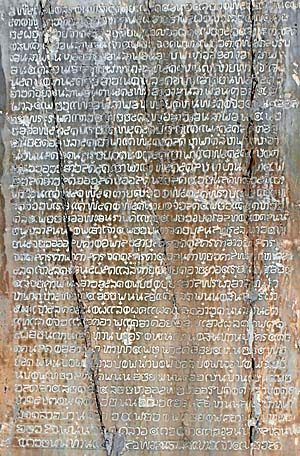The Ramkhamhaeng inscription is regarded as unique and specific to Thailand. In the late 1980s a discussion started about its authenticity (see Vickery 1987). While working on a project on state ideologies, we noticed that a similar inscription could be found in Bagan. After some research, it became obvious that a lot of what is described in the Ramkhamhaeng inscription quite closely resembles a story from 1st century B.C. Tamil literature. In short it is as follows:
A king had a bell hung over his bed that could be pulled from the front of his palace. Every subject feeling treated unjustly could ring it and ask for redress. Once a cow rang the bell because the king’s son had run over her calf with his chariot. In retribution, the king had his son run over and killed by a chariot as well.
The earliest instance of the myth is found in the poems of the Tamil Purananuru, 1st century B.C. till 1st century A.D. It appears again in the Cilappatikaram and the Manimekalai (8th to 10th centuries) and is worked into a religious epic, the Periyapuranam, in the 12th century. In the 19th century it was worked into a purely religious epic by Ramalingam Swami.
In India the myth changes considerably over time. Initially the name of the king was Elara, a rather mythical figure. In the 12th century the king turned into the Cola king Manuniticholan. His name, roughly translated as “the one following the law”, indicates that the story was that everybody is equal under the supreme law. Today the statue of Maniniticolan stands in front of the Madras High Court. From a historical point of view it is rather doubtful whether Elara and/or Manuniticolan have been real persons. Currently there is a controversy about it in Tamil networks.
From South India the myth traveled to Sri Lanka. This probably occurred fairly early. The name of the king was still Elara, which might be taken as indicator that it arrived in Sri Lanka far before the 12th century. With the rise of Buddhism in Myanmar the story was picked up in 10th century Bagan. There it underwent a metamorphosis: the king became the righteous Buddhist king, or the dharmaraja. So far, we found some evidence that the myth was probably known in the Khmer empire as well. In any case, it can be assumed that the story was known in ancient Sukhothai either from contacts to Bagan, or from Khmer sources. A colleague from Myanmar told us that in the 18th and 19th century it became again quite popular in Myanmar. If this is the case, it probably found its way to Bangkok as well.
In Thailand the story still shapes historical and political perceptions. The myth was historicised and the putting up of the bell attributed to the historical king Ramkhamhaeng of Sukhothai (12th century) who in an inscription related this episode minus the gruesome end. For us it is quite surprising that it is regarded as unique to Thailand, and the ancient background widely ignored.
In general, the ancient myth was applied to legitimise state formation (the rise of the law) and monarchical rule. In the ancient original, the law was divine and thus the ruler himself had to obey it, even if it meant to kill his son. The Sukhothai version describes the ruler as the one making the law and thus as adjudicator. As such he was above the law.
Source
Vickery, Michael T. “The Ramkhamhaeng Inscription: A Piltdown Skull of Southeast Asian History?” 3rd International Conference on Thai studies, Canberra, Australia. 1987.
D. Hellmann-Rajanayagam and Ruediger Korff are with the Southeast Asian Studies program, University of Passau. The argument presented here is part of a larger project.
 Facebook
Facebook  Twitter
Twitter  Soundcloud
Soundcloud  Youtube
Youtube  Rss
Rss 